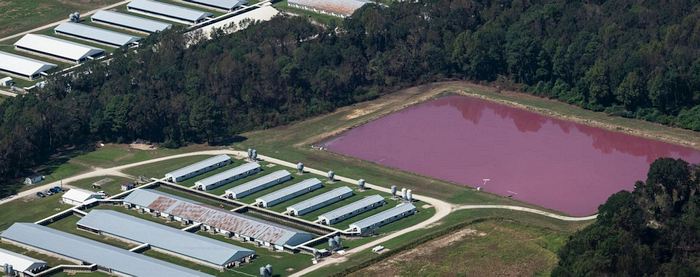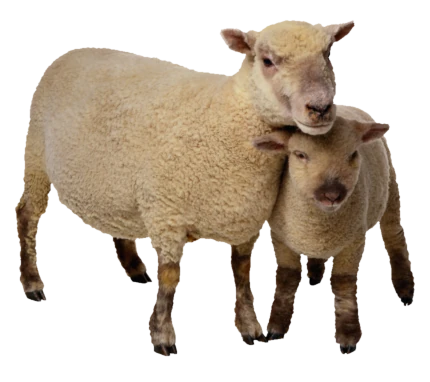The environmental costs of factory farming—such as global warming, pollution, and diminished biodiversity—are too great for these facilities to continue dominating our food system.
Thanks to undercover investigations, documentaries, and other educational efforts, the plight of animals in the factory farming industry is becoming increasingly clear. Less widely known, however, are the environmental impacts of these facilities.
Whether it’s polluting the air and water, contributing huge volumes of greenhouse gases that exacerbate climate change, or threatening wild species with extinction, there is ample evidence to demonstrate why it’s high time factory farming itself goes extinct.
WHAT IS FACTORY FARMING?
Factory farming is a form of intensive agriculture that involves confining large numbers of animals within small, sorely inadequate living spaces for companies to maximize profits in selling their bodies or milk to consumers. Various species are targeted for factory farming, including pigs, cows, sheep, turkeys, chickens, and ducks.
Routine mutilations, whether severing portions of birds’ beaks or lopping off the tails of cows and baby sheep, as well as the endless application of antibiotic drugs, are defining features of factory farms.
HOW DOES FACTORY FARMING DAMAGE THE ENVIRONMENT?
Factory farming may seem like an efficient way to produce cheap eggs, meat, and dairy products, but these facilities are giving rise to some of the worst environmental catastrophes currently plaguing the planet.
Air pollution
Air pollution is the result of confining huge numbers of animals within small areas and indoor spaces. Many people don’t realize that poultry farms, where birds raised for meat or eggs are confined indoors for the majority of their lives, are among the worst sources of air pollution. The birds’ litter, where vast quantities of feces are left to ferment, releases the toxic gas ammonia. Air pollution may affect not only animals’ health but the health of workers and even the surrounding community.
Water pollution
Water pollution is another direct result of confining huge numbers of animals within small spaces, when in the wild they would be spread across vast distances, allowing their waste to fertilize the land without harming it. Water runoff from factory farms occurs when freshwater—either groundwater or surface water such as streams and rivers—comes into contact with sewage. The water carries the sewage away, eventually winding up in the ocean and along coastlines.
“
Agricultural runoff is one of the leading causes of water pollution in the US.
Such pollution can lead to dead zones, areas in the ocean where a proliferation of compounds (like the nitrates found in animal waste) cause algal blooms that deplete the oxygen in the water and kill marine life. Agricultural runoff is among the leading causes of water pollution in the US.
Global warming
Global warming is caused by certain gases, such as methane, nitrous oxide, and carbon dioxide, that are collectively known as greenhouse gases. An estimated 14.5% of the global output of greenhouse gas emissions comes from animal agriculture, primarily from cattle in the beef and dairy industries.
Deforestation
There’s a reason you don’t often see cattle roaming through forests. Cows grow quickest on open pastures with abundant access to grass, so these environments are preferred by farmers who want their cattle to swiftly put on weight so they can be sold for slaughter as soon as possible. While grasslands naturally exist in many places around the world, forests are increasingly being razed to create more pastures for ever-growing populations of cattle—all because of consumer demand for steaks, hamburgers, and the like.
Besides creating pastureland, forests are also cleared to make way for the vast areas of cropland required to grow food for the billions of animals confined within factory farms. Animals like chickens, turkeys, and cattle on feedlots and in dairy barns are fed crops such as soy, corn, and other grains.
This combined assault is particularly damaging for the Amazon rainforest, much of which falls within the borders of Brazil. The country is one of the biggest exporters of beef worldwide. Unsurprisingly, animal agriculture is considered to be one of the primary drivers of deforestation within this critical habitat and around the world.
Water use
Freshwater is an increasingly precious resource, yet factory farms use plenty of it for their animals. A single dairy cow requires 40-50 gallons of water each day, for both drinking and cleaning purposes, since the intensely crowded conditions on factory farms require a constant battle to be waged on the build-up of excrement.
The crops grown for animal feed are also thirsty. The soy, corn, and other grains typically used in animal feeds require up to 43 times more water than feed based on roughage, such as grass, or allowing animals to graze—something animals in factory farms are typically denied for their whole lives.
Wildlife and biodiversity
The vast tracts of land required for meat production, as well as the deluge of pollution and other impacts that are degrading ecosystems, threaten the existence of wildlife and a biologically diverse planet. A study in 2021 found that land-use conversions for meat production were the primary driver of biodiversity loss. Lamb and cattle raised for beef require the most land of any proteins that humans consume, and thanks to surging demand for meat globally, wildlife habitats are being encroached upon at unprecedented rates. Destroying habitat is a death sentence for the animals living there, many of which are already endangered species.
Oceans and fisheries
Oceans are impacted by factory farming in numerous ways. Agricultural runoff pollutes oceanic habitats thanks to two sources: runoff from crops grown to feed factory-farmed animals which contain high levels of pesticides and synthetic fertilizers, and animal excrement from factory farms themselves. Such runoff can cause algae blooms that lead to dead zones, upsetting entire ecosystems.
Factory farms are also being directly immersed in the water. A form of aquaculture, which also includes farmed shellfish and seaweed, fish factory farms are concentrated animal feeding operations for species like salmon. These open-water cages, often located in relatively pristine and biodiverse areas of the ocean, produce pollution thanks to fish excrement and liberal use of antibiotics which are required to keep fish alive in these highly unnatural conditions. Despite best efforts, however, factory-farmed fish frequently contract painful and often lethal diseases such as parasitic lice which can then contaminate adjacent wild populations of fish. Each year in Norway, an estimated 50,000 wild salmon succumb to lice infections.
Rural communities
Factory farming is big business. Thanks to vertical integration, these facilities do not turn to the community in order to purchase equipment or services, relying upon far-flung distributors instead. Their ability to undercut smaller farms squeezes out local competition from smaller farms. Factory farms pay the lowest wages, often resulting in the departure of locals who must seek higher-paying work elsewhere and attract workers who are often impoverished immigrants, many of whom are undocumented and forced to accept the worst of pay and working conditions. These compounding effects result in the hollowing-out of rural communities and disrupting the long-held social fabric.
In addition to these economic consequences, rural communities must also put up with the serious environmental impacts, or else leave if they are able, which many are not. People living near factory farms complain of terrible odors, with swine operations being a major culprit of air air pollution that can cause high rates of asthma and acute respiratory syndromes. Young children are particularly susceptible to these conditions. Mood disorders such as depression, trouble sleeping, and anxiety are also commonly reported.
FACTS ABOUT FACTORY FARMS AND THE ENVIRONMENT
- A dairy farm with 200 cows produces approximately 24,000 pounds of manure every day—and this is only for a mid-sized dairy farm.
- In the year 2012, factory farms generated nearly 370 million tons of animal excrement.
- Roughly a quarter of the global supply of freshwater—an increasingly scarce resource—is used to produce meat and dairy.
- Estimates in 2021 project that over 1,000 species will lose at least a quarter of their habitats by 2050 if meat consumption continues unabated.
- Farmed chickens account for 57% of all bird species on the planet by weight.
WHAT YOU CAN DO FOR THE ENVIRONMENT
The environmental costs of factory farming are simply too great for these facilities to be allowed to continue overtaking the food industry. There are many ways you can get involved with the movement to put a permanent end to factory farming. One effective way is to reduce or eliminate your consumption of animal products and adopt a plant-based diet. You can also check out our Take Action page to learn more about volunteer opportunities or events you can attend in your area.
Together we can compel this industry to clean up its act and stop it from destroying the environment upon which we all depend.

